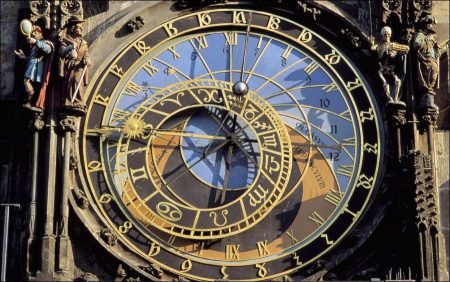The Astronomical Clock on the Old Town Hall is one of the major sights of the city and many visitors mention it as one of the most outstanding things to see in Prague. It reveals the respectful regard that people of the past felt for the heavenly order.
A number of fictitious legends relate to this Clock. For a long time it was believed that it was built sometime around 1490 by a clockmaster Jan Ruze (Hanus) and his assistant Jakub Cech. It has only been possible in recent times to prove convincingly that the Prague Astronomical Clock is considerably older and that it was made in the year 1410. It was constructed by the clockmaker Mikulas of Kadan in collaboration with Jan Ondrejuv called Sindel, professor of mathematics and astronomy of Prague Charles University.
The astronomical dial (astrolabe on the clock face) with its mechanism is working to this day. It was only in the second phase, probably in 1490, that a calendar dial was added under the astronomical dial. At that time the entire facade of the Astronomical Clock was richly decorated with striking Vladislav Gothic (which is the Czech equivalent of Flamboyant Gothic) stone sculptures. The important exceptions are the sculpture flanking the astronomical dial and mask and figures on its architrave which were created at the beginning of the 15th century by members of the masonic lodge of stonemasons and sculptor led by Peter Parler.
The Clock continually provides the full range of astronomical data. The dial shows three mutually independent movements: the mean revolutions of the Sun, the mean revolutions of the Moon and the apparent revolutions of the stars (the ecliptic, to be more precise). The horizon is indicated by the boundary of blue and red; in the left part the day-break (AVRORA) with a rising border (ORTVS), in the right part the twilight (CREPVSCVLVM) with a setting border (OCCASVS). The dark circle at the bottom displays the astronomical night. Three pointers rotate around this dial: one for the Sun, one for the Moon and the third is for zodiac.
In the clockwork there are three great co-axial wheels of the same diameter, driven by the same pinion, with 365, 366 and 379 cogs. The first of these gearing the zodiac and the indicator with asterisk rotates once a sidereal day. The second gears the indicator of the Sun and rotates once a mean solar day. The third gearing the Moon’s pointer rotates accordingly with the mean apparent motion of the Moon. The ball, half silvered and half black, rotates every synodic month and displays its phase.
Visits: 96



